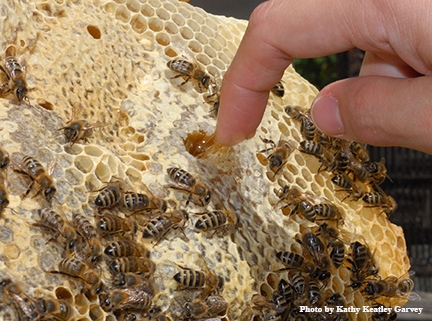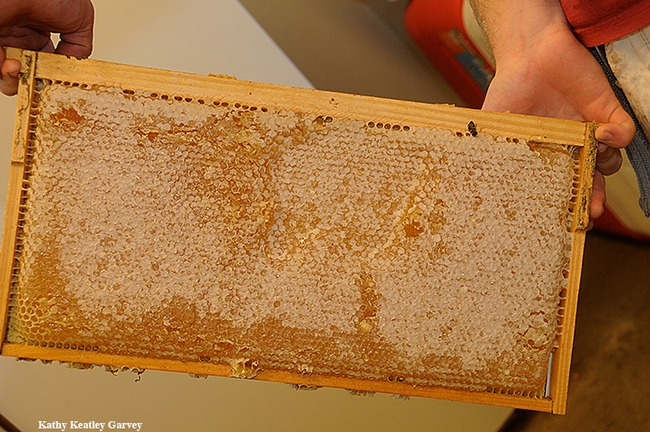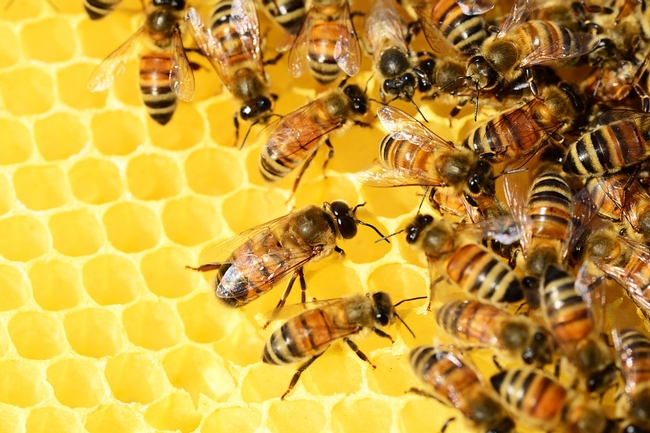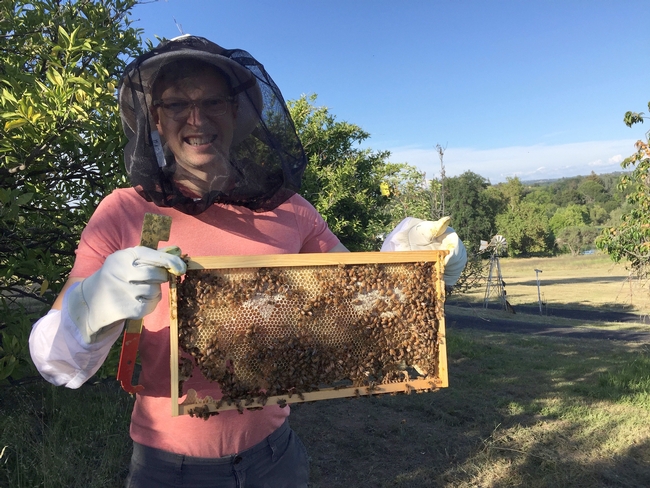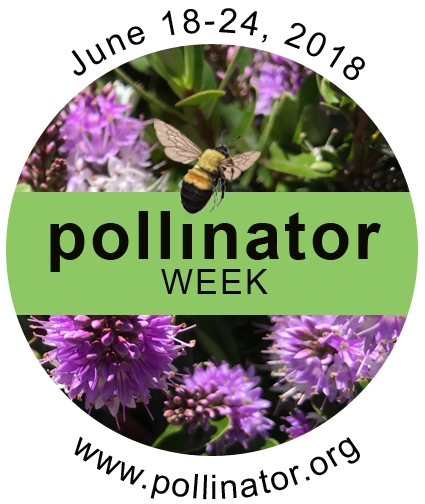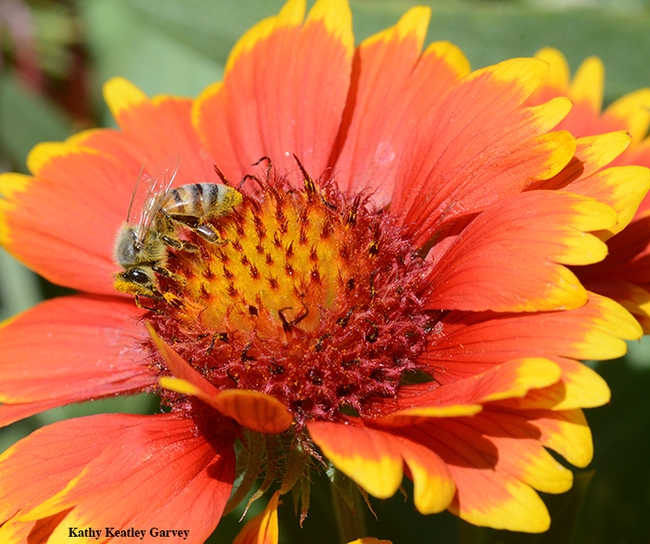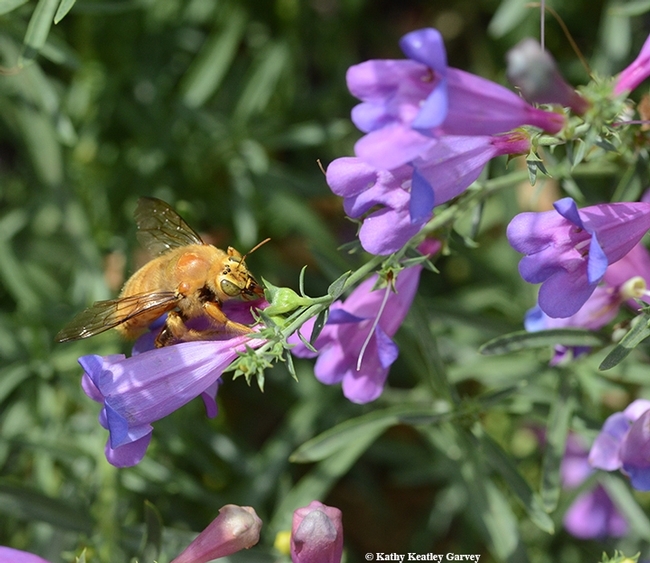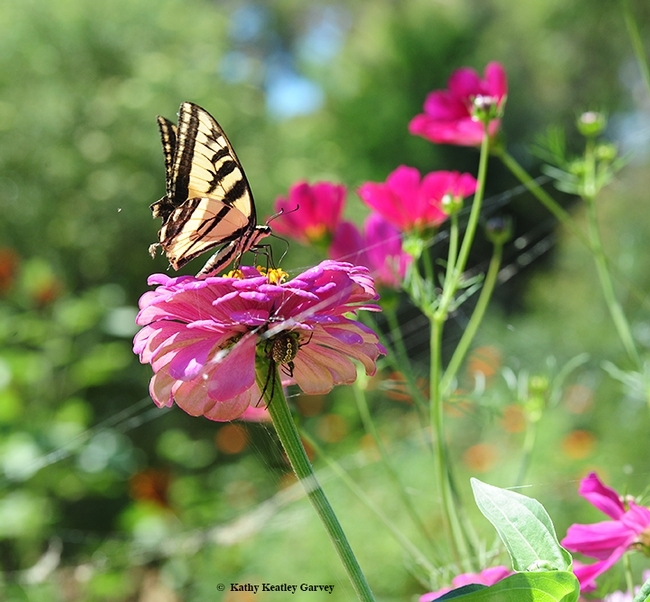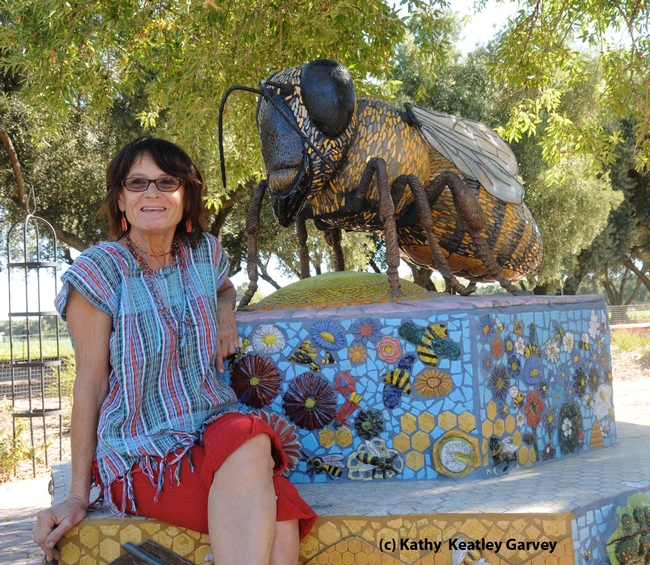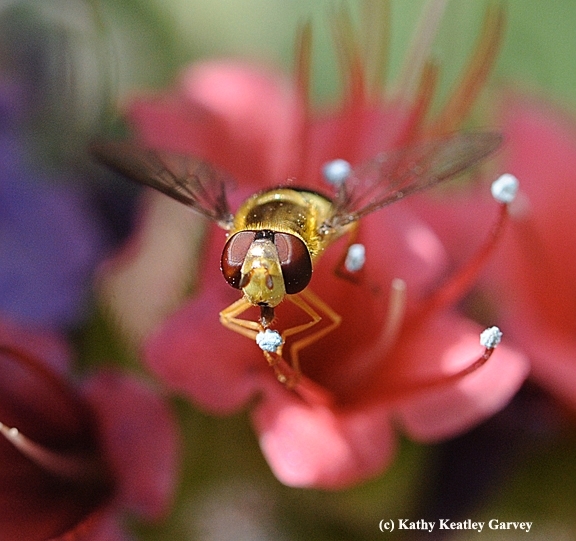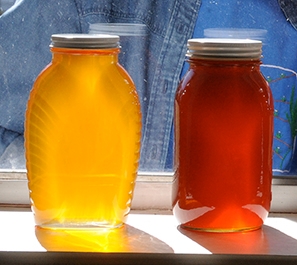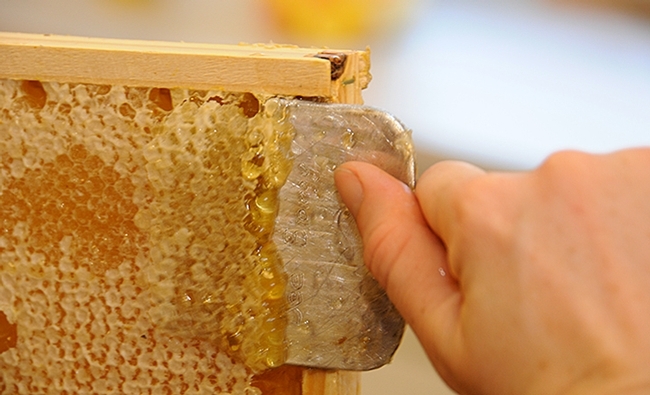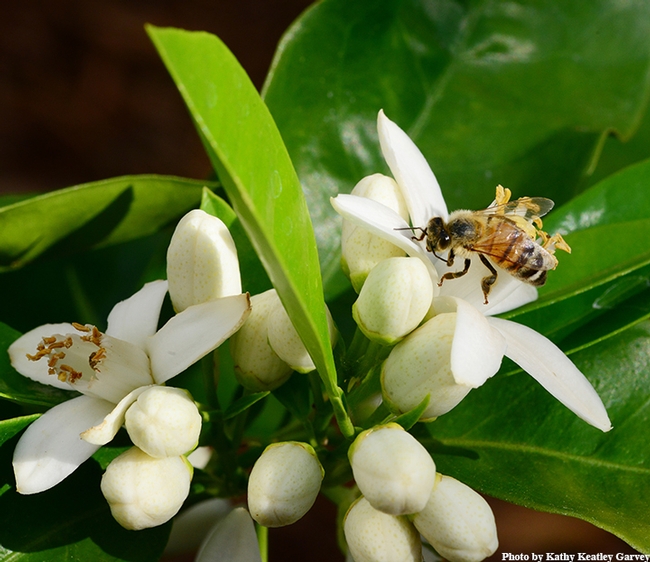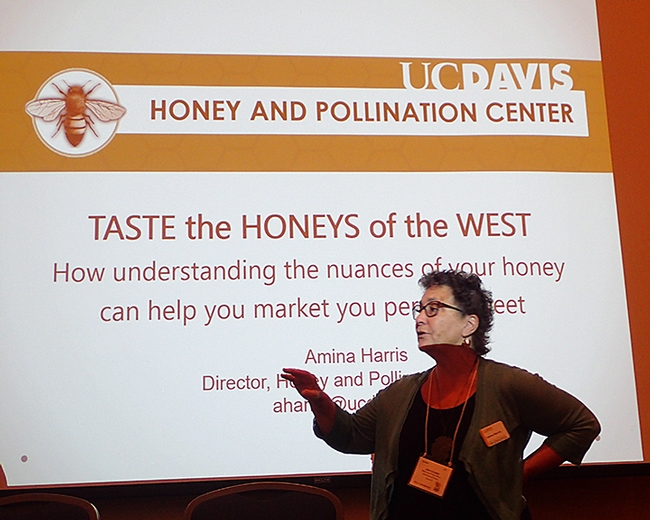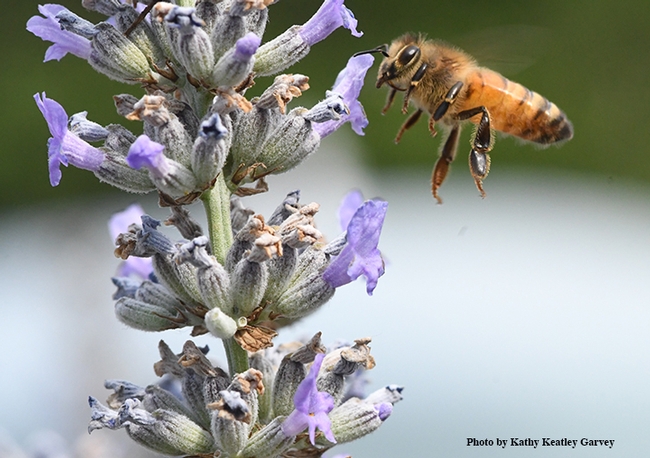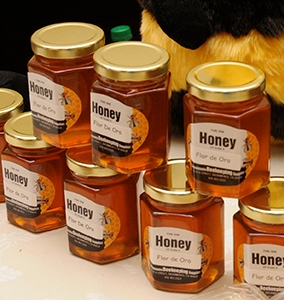Posts Tagged: honey
Honey: Nothing short of miraculous
“Honey, please pass the honey!”
That simple request, prefaced with a term of endearment for good measure, means there's honey on the table.
And well there should be. As the daughter, granddaughter and great-great granddaughter (and beyond) of beekeepers, I grew up with honey on the table. (And on my fingers, face and clothes.)
My favorite then was clover honey from the lush meadows and fields of our 300-acre farm in southwest Washington. My favorite now is Northern California yellow starthistle honey, derived from the blossoms of that highly invasive weed, Centaurea solstitialis, which farmers hate (and rightfully so) and beekeepers love.
“Almost every honey has its own unique flavor-- even when it is the same varietal,” says Amina Harris, director of the UC Davis Honey and Pollination Center. “There are characteristics we learn to look for, but even within that variety, the honey will differ from each area collected. For instance: avocado honey is known for being very dark amber with a flavor reminiscent of molasses, licorice or anise. However, once you start tasting a selection, some will taste like blackstrap molasses and very black licorice. Others will have almost a fruity flavor like dried figs or prunes. Most folks can't tell the difference – and then there are the honey nerds, like me!”
“My favorite all-around honey is one I keep returning to. I love sweet clover from the High Plains with its cinnamon hit —the spicy characteristic is just something I love,” Harris said. “My favorite ‘shock honey' is coriander. Collected near Yuba City, this seed crop gives us a honey that is like walking through a spice bazaar with hints of cardamom, cinnamon, allspice, nutmeg, coriander and — chocolate.”
The UC Davis Honey and Pollination Center, located in the Mondavi Institute for Wine and Food Science on Old Davis Road, periodically offers courses on the sensory evaluation of honey, as well as honey tastings. Next up: the center will host free honey tastings at its home base during the 105th Annual Campuswide Picnic Day on April 13, and at the California Honey Festival in downtown Woodland on May 4. Another popular honey tasting: California Extension apiculturist Elina Lastro Niño, based in the UC Davis Department of Entomology and Nematology, hosts a honey tasting at Briggs Hall during the annual Picnic Day.
There's more to honey than meets the eye — or the palate. The Honey and Pollination Center recently hosted a three-day Sensory Evaluation of Honey Certificate Course last October, using “sensory evaluation tools and methods to educate participants in the nuances of varietal honey,” Harris said. Northern California public radio station KQED spotlighted the course on its “Taste This” program.
And we owe it all to honey bees.
Pollination ecologist Stephen Buchmann of the University of Arizona (who received his doctorate in entomology from UC Davis, studying with native pollinator specialist Robbin Thorp), writes in his book, Honey Bees: Letters from the Hive, that each worker bee “may make four to ten or so flights from the nest each day, visiting hundreds or many thousands of flowers to collect nectar and pollen. During her lifetime, a worker bee may flown 35,000 to 55,000 miles collecting food for her and her nest mates. One pound of honey stored in the comb can represent 200,000 miles of combined bee flights and nectar from as many as five million flowers.”
Take a 16-ounce jar of honey at the supermarket. That represents “the efforts of tens of thousands of bees flying a total of 112,000 miles to forage nectar from about 4.5 million flowers,” writes Buchmann.
Of course, we primarily appreciate honey bees for their pollination services (one-third of the food we eat is pollinated by bees) but honey is more than just an after thought.
It's been described as “liquid gold,” “the nectar of the gods” and “the soul of a field of flowers.” Frankly, it's nothing short of miraculous.
And well it should be.
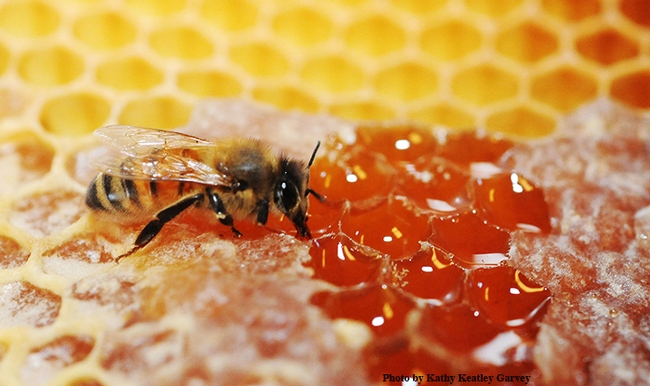
A honey bee sips honey from honeycomb. (Photo by Kathy Keatley Garvey)
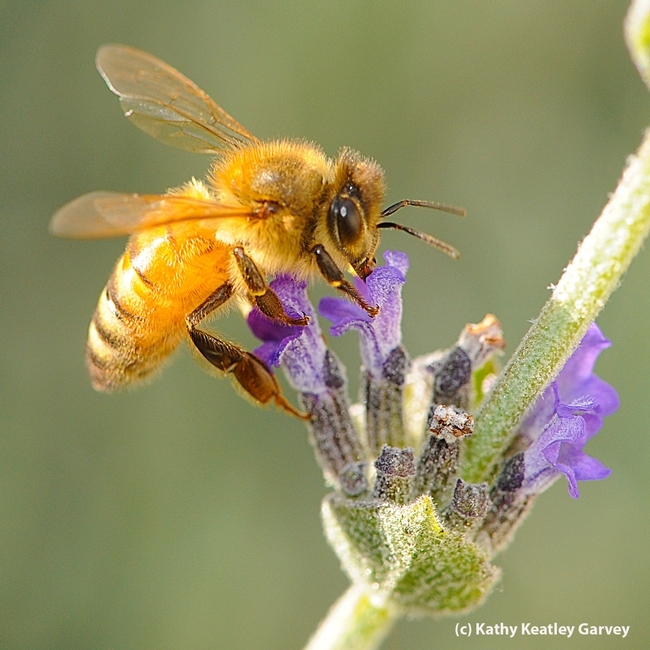
A honey bee sips nectar from a lavender blossom. (Photo by Kathy Keatley Garvey)
Honey bee health key to wellbeing of important species
Our friends the honey bees make it possible for us to devour an abundance of almond products. In 2016 the California almond crop totaled 2.15 billion pounds valued at $5.2 billion. Growing 80 percent of the world's almonds in California takes a lot of honey bees for pollination, roughly two hives for every acre of almond trees. It's estimated that California has 1.3 million acres of almonds, stretching 400 miles between Bakersfield and Red Bluff.
California is rated in the top five honey producing states in the nation. The U.S. per capita consumption of honey is around 1.3 pounds per year. Our buzzing friends visit millions of blossoms, making pollination of plants possible and collecting nectar to bring back to the hive. Lucky for us bees make more honey than their colony needs allowing beekeepers the opportunity to remove the excess honey and bottle it for us to enjoy.
Bees are animals too
Bees are one of our planet's most important animals. They produce honey and they are the primary managed pollinators for a majority of high value specialty crops grown in the contiguous states of California and Oregon, such as nuts, stone fruits, vegetables, and berries. A problem looms for our animal friends, the bees. Colony losses are high due to a variety of environmental and biological causes including bacterial diseases. Historically, beekeepers have self-prescribed antibiotics to control these diseases.
Enter UC Davis and Oregon State University to aid beekeepers in addressing the problem of antibiotic resistance and antimicrobial use in the feed or water of food-producing animals, namely, protecting the health and safety of bees. The overall strategy leads to a safer food supply because the potential for antibiotic resistance is reduced.
The Western Institute for Food Safety and Security (WIFSS), UC Cooperative Extension, and UC Davis School of Veterinary Medicine are partnering with Oregon State University in a USDA funded multi-state specialty crop project to develop CE training for veterinarians on bee health and antibiotic use — a practice that is now regulated under the Veterinary Feed Directive (VFD). The project will offer a comprehensive bee biology online course and train-the-trainer practical training for veterinarians and apiculture educators. The ultimate goals are to protect the specialty crop — honey — from becoming contaminated with antibiotic residues; to protect the health and safety of bees, which are essential to California agriculture; and, finally, to support veterinary oversight in the use of antibiotics, which will lead to an overall reduction of antibiotic resistant bacteria in the environment.
The $483,278 award will address the unique needs of the beekeeping industry that have been experiencing high colony losses since 2006. It will also focus on new rules established by the U.S. Food & Drug Administration on the use of antibiotics which are used to control certain diseases affecting bee colonies.
The principal investigator is Elina L. Niño, a UC Cooperative Extension specialist with the UC Davis Department of Entomology and Nematology. Project leader is Bennie Osburn, director of outreach and training at WIFSS. Collaborating in the project is Jonathan Dear, from the Department of Medicine and Epidemiology at UC Davis School of Veterinary Medicine, and the partner state collaborator is Ramesh Sagili from the Department of Horticulture at Oregon State University. A team of graphic and instructional designers from WIFSS will work with Drs. Niño, Dear, and Sagili, to translate the science into user friendly information for veterinarians and beekeepers.
Educating about honey bee health
Dear who is collaborating with WIFSS to produce an online and hands-on module to train veterinarians about beekeeping and honey bee health, points out that, “Honey bees are such an important part of our economy and, like any food producing animal, they can be affected by preventable and treatable diseases.”
He is enthusiastic about the project and says, “Our hope is that by educating veterinarians about honey bee health, they can play a key role in maintaining the health and wellbeing of this important species.”
With the efforts of extension specialists, veterinarians, and graphic and instructional designers, beekeepers and veterinarians will work together to navigate the VFD regulations, and consumers will continue to enjoy nature's sugar.
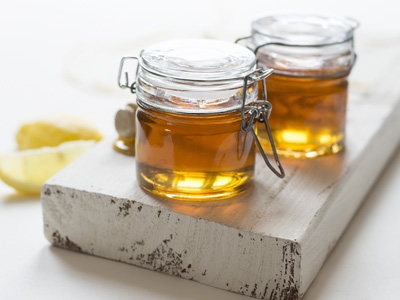
UCANR-Honey-400x300
National Pollinator Week: Open house at UC Davis Bee Garden
June 18-24 is National Pollinator Week.
Do you know where your pollinators are? Think bees, birds, butterflies, bats and beetles.
And think flies. Especially syrphid flies, also known as "flower flies" and "hover flies."
The UC Davis Department of Entomology and Nematology is hosting an open house during National Pollinator Week from 11 a.m. to 2 p.m. at its bee garden, Häagen-Dazs Honey Bee Haven on Bee Biology Road, west of the central UC Davis campus.
Here's what you can expect to see or do:
- learn how to catch and observe bees up close
- see honey bees at work in an observation beehive
- learn about bee diversity and identification
- learn about what and how to plant for bees
- learn about growing and good pollination in home fruit gardens
- see easy-to-grow bee plants and solitary bee houses available for a donation to the garden.
The Häagen-Dazs Honey Bee Haven, installed in the fall of 2009 and located next to the Harry H. Laidlaw Jr. Honey Bee Research Facility on Bee Biology Road, off Hopkins Road, is a half-acre garden devoted to bee pollinator conservation and education. It was founded and sprang to life during the term of interim department chair, Professor Lynn Kimsey, director of the Bohart Museum of Entomology, who coordinated the entire project. Kimsey was singled out for her work when the Pacific Branch of the Entomological Society of America honored her and four others – "The Bee Team"– with the 2013 outstanding team award.
A Sausalito team – landscape architects Donald Sibbett and Ann F. Baker, interpretative planner Jessica Brainard and exhibit designer Chika Kurotaki – won the design competition. The judges were Professor Kimsey; founding garden manager Missy Borel (now Missy Borel Gable), then of the California Center for Urban Horticulture; David Fujino, executive director, California Center for Urban Horticulture at UC Davis; Aaron Majors, construction department manager, Cagwin & Dorward Landscape Contractors, based in Novato; Diane McIntyre, senior public relations manager, Häagen-Dazs ice cream; Heath Schenker, professor of environmental design, UC Davis; Jacob Voit, sustainability manager and construction project manager, Cagwin and Dorward Landscape Contractors; and Kathy Keatley Garvey, communications specialist, UC Davis Department of Entomology and Nematology.
Others with a key role in the founding and "look" of the garden included the UC Davis Art/Science Fusion Program, founded and directed by the duo of entomologist/artist Diane Ullman, professor and former chair of the UC Davis Department of Entomology, and self-described "rock artist" Donna Billick of Davis. Miss Bee Haven, a six-foot long worker bee sculpture, the work of Billick, anchors the garden. The art in the garden is the work of their students, ranging from those in Entomology 1 class to community residents. Eagle Scout Derek Tully planned, organized and built a state-of-the-art fence around the garden.
Why are pollinators so crucial? Take it from the Xerces Society for Invertebrate Conservation:
"Pollinators are essential to our environment. The ecological service they provide is necessary for the reproduction of over 85 percent of the world's flowering plants, including more than two-thirds of the world's crop species. The United States alone grows more than 100 crops that either need or benefit from pollinators, and the economic value of these native pollinators is estimated at $3 billion per year in the U.S. Beyond agriculture, pollinators are keystone species in most terrestrial ecosystems. Fruits and seeds derived from insect pollination are a major part of the diet of approximately 25 percent of all birds, and of mammals ranging from red-backed voles to grizzly bears. In many places, the essential service of pollination is at risk from habitat loss, pesticide use, and introduced diseases."
So, on Saturday, June 23, you won't see any red-backed voles or grizzly bears. But you'll see bees, butterflies, birds and beetles.
And flies. Syprhid flies.
For more information on the open house, access https://hhbhgarden.ucdavis.edu/wp-content/uploads/2018/01/Pollinator-week-flyer-2018-1.pdf
A honey of an educational odyssey -- and you're invited
Show me the honey!
You've probably tasted wine in California's acclaimed Wine Country, but have you ever tasted honey in the nation's rapidly growing “Honey Country”—the University of California, Davis?
Now you can.
The UC Davis Honey and Pollination Center is hosting a Honey Sensory Experience next month so you can learn all about honey, taste honey varietals from all over the world, and hear what researchers are doing.
The Honey Sensory Experience is scheduled for Nov. 10-11 in the Robert Mondavi Institute for Wine and Food Science's Sensory Building on Old Davis Road. The course is for beekeepers, bakers, mead makers, honey lovers, packers, importers, professional buyers, honey producers, and "anyone who wants to gain expertise in the aroma of honey analysis," said Amina Harris, director of the UC Davis Honey and Pollination Center, which is closely affiliated with the Robert Mondavi Institute for Wine and Food Science and the UC Davis Department of Entomology and Nematology, part of the UC Agriculture and Natural Resources (UC ANR). "Over two days, expert teachers will guide participants through a unique tasting and educational odyssey."
The event revolves around a first-of-its-kind study in the United States. or the past nine months, the center has been working with a team of sensory experts and trained tasters in the sensory lab in the UC Davis Department of Food Science and Technology. The panel analyzed the flavor, aroma, color, pollen and nutrition of three varietal honeys with samples produced across the nation.
The center's goal is to create a description of each varietal honey's unique characteristics.
“We have about 300 varietal honeys here in the United States,” Harris pointed out. “Many aren't produced each year. And some years actually have a better crop than others. Our center's goal is to help consumers understand what each varietal honey should really taste like.”
Well-known varietals include orange blossom and clover honeys, although these are rarely pure varietals, Harris said.
“According to current honey labeling laws, the varietal listed on the label need only be the predominant floral source. Simply, a blended honey of 23 percent alfalfa, 25 percent wildflower and 25 percent cotton with 27 percent orange blossom can be labeled ‘Orange Blossom Honey.' Swap out the orange blossom for clover and you have a new varietal.”
Harris said the center is "ready to share our experiences. Together we will spend two full days tasting varietal honeys from the world over and investigating the bees' handiwork. It all starts with nectar.”
The Honey and Pollination Center, at the forefront of honey sensory research, developed the first-ever Honey Flavor and Aroma Wheel. The wheel has been featured on National Public Radio, at the Smithsonian, and at tastings and specialty food conferences across the country.
With interest in honey is on the rise, consumers are actively looking for intriguing varietals, said Harris, who has tallied 35 years of experience in the world of varietal honeys. “The Honey Sensory Experience is the perfect opportunity for consumers looking to better-understand how honey is developed—from the moment the honey bee collects the nectar, until the honey is on the supermarket shelf."
"The two-day program “will bring together a group of exceptional presenters to explain all the nuances from nutrition to flavor to cooking."
In addition to Harris, the presenters will include Orietta Gianjorio, member of the Italian Register of Experts in the Sensory Analysis of Honey; Hanne Sivertsen, sensory researcher, UC Davis Department of Food Science and Technology; Amy Myrdal Miller, certified nutritionist and owner of Farmer's Daughter Consulting, Sacramento; Joyce Schlacter, certified quality control specialist and director of food safety and quality, Smitty Honey, Iowa; chef Mani Niall, owner of Sweet Bar Bakery, Oakland, Calif. and Extension apiculturist Elina Lastro Niño, based in the UC Davis Department of Entomology and Nematology.
Niall, known as “Baker to the Stars,” served as a chef to Michael Jackson and a chef for the National Honey Board in the 1990s. He is the author of the book, Covered in Honey: The Amazing Flavors of Varietal Honey.
Miller, a UC Davis graduate, is an “amazing nutritionist,” Harris said. She is a farmer's daughter, a highly regarded public speaker, published author, and founder and president of Farmer's Daughter Consulting, a privately-held agriculture, food, and culinary communications firm.
The Honey and Pollination Center is sponsored by the Robert Mondavi Institute for Wine and Food Science and the UC Davis Department of Entomology and Nematology, part of the UC Agriculture and Natural Resources (UC ANR).
The course, which includes breakfast and lunch each day, is $625. To access the agenda and to register, see http://honey.ucdavis.edu/events/honey-sensory-experience-an-introduction.
How to make something sweet even sweeter
It's more than that if you're a beekeeper. It's your pride and joy.
Whether beekeeping is your livelihood, your leisure activity, or something you do to help the declining bee population, that byproduct of your bees--honey--can also be an opportunity for bragging rights.
Entries are now being accepted for the nationwide honey competition sponsored by Good Food Awards.
If you're one of the nation's beekeepers, there's still time to enter your honey, says contest coordinator Amina Harris, director of the UC Davis Honey and Pollination Center.
The deadline to do so is Sunday, July 31. The four subcategories are Liquid and Naturally Crystallized, Creamed, Comb, and Infused Honey.
The contest is divided into five regions--East, South, North, Central and West--with seven or more states assigned to one region, Harris says.
- West: California, New Mexico, Arizona, Hawaii, Nevada, Hawaii and Alaska.
- North: Oregon, Washington, Idaho, Montana, Wyoming, North and South Dakota and Minnesota
- Central: Colorado, Nebraska, Kansas, Missouri, Iowa, Illinois, Wisconsin, Michigan, Indiana, Ohio and Kentucky
- East: Maine, New Hampshire, Vermont, New York, Pennsylvania, Massachusetts, Connecticut, Rhode Island, New Jersey, Maryland and West Virginia
- South: Virginia, North and South Carolina, Tennessee, Georgia, Florida, Alabama, Mississippi, Arkansas, Oklahoma, Louisiana and Texas
"Finalists from each region are selected on a tasting day in September," Harris explains. "They are vetted according to criteria on this page. Winners are selected during the fall months and announced at the end of the year. The awards will be presented in mid-January."
Harris says there are more than 300 unique types of honey in the United States. The Good Food Awards will showcase honeys most distinctive in clarity and depth of flavor, produced by beekeepers practicing good animal husbandry and social responsibility. The honey can come from hives located in numerous places, from rooftops to fields to backyards.
Last year's top awards went to:
- Bee Girl, Bee Girl Honey, Oregon
- Bee Local, Bee Local Sauvie Honey, Oregon
- Bee Squared Apiaries, Rose Honey, Colorado
- Bees' Needs, Fabulous Fall, New York
- Bloom Honey, Orange Blossom, California
- Gold Star Honeybees, Gold Star Honey, Maine
- Hani Honey Company, Raw Creamed Wildflower Honey, Florida
- Mikolich Family Honey, Sage and Wild Buckwheat, California
- MtnHoney, Comb Honey Chunk, Georgia
- Posto Bello Apiaries, Honey, Maine
- Sequim Bee Farm, Honey, Washington
- Simmons Family Honey, Saw Palmetto Honey, Georgia
- Two Million Blooms, Raw Honey, Illinois
- UrbanBeeSF, Tree Blossom Honey Quince & Tree Blossom Honey Nopa, California
To enter the competition, access this page: http://www.goodfoodawards.org/honey/
The Honey and Pollination Center is affiliated with the Robert Mondavi Institute for Wine and Food Science and the UC Davis Department of Entomology and Nematology. For more information, email Harris at aharris@ucdavis.edu.
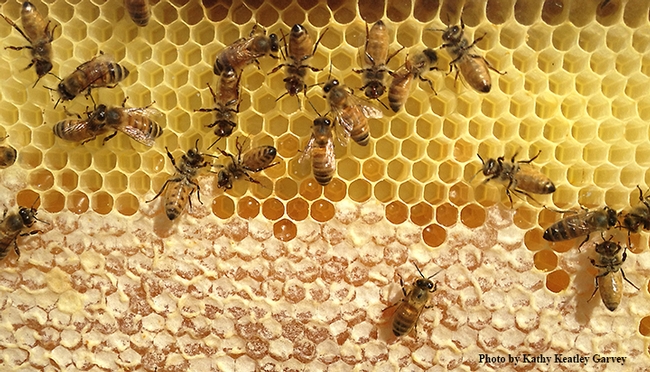
Honey bees in the process of making honey. This photo was taken through a bee observation hive. (Photo by Kathy Keatley Garvey)

